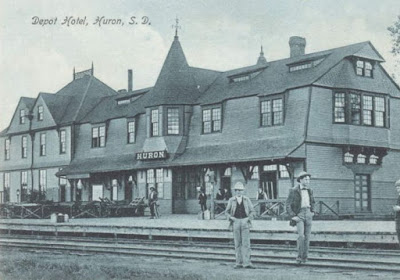Bill Knutz and Lillian Christensen knew each other nearly their whole lives. As children, their parents' farms were located around the corner from each other, less than a mile apart. The children of both families attended the same rural school and formed close friendships throughout the years. Bill and Lillian's brother Ray were best of friends, but it was Lillian really caught Bill's attention.
Bill loved to tell their grandchildren the story of how they "laid claim to each other" in the third grade. Bill's route to school took him past the Christensen farm. One morning, Bill and his brother Howard, in their horse-drawn buggy, ran into Lillian and Raymond Christensen in their buggy. A race ensued, but unfortunately, the wheels of the two buggies became entangled and locked together. Needless to say, the next day (and every day thereafter), Bill and Howard could be seen riding a single horse to school The same thing held true for Lill and Ray. But down the road a distance they would do a switch; Ray and Howard would end up on one horse, and Bill and Lillian on the other.
 |
| At Sunnyside school, early 1920s, Bill Knutz and Lillian Christensen (marked with X) |
On one occasion, when the kids were in third grade, Bill got sick and missed a few days of school. The teacher asked Lillian to sit next to him and show him the lesson. Bill said, "I got a feeling all through my body, like I wanted to put my arm around her waist and give her a hug."
One of Bill's favorite stories was when Lillian wanted to see if he was an honorable fellow, or a snitch. One day at school, a girl named Harriet dropped her mitten. Ray grabbed it and hung it on a nail in the barn. The teacher asked Lillian who did it, and she said it was Bill. Bill did not "squeal" on Ray, even though he had to spend noon hours inside all week. And he married her anyway!

As teenagers, Lillian moved to town and took a job as a nanny. Bill worked as a farm hand for Mr. Peterson, whose daughter had a crush on Bill and would stop at nothing to get him. Lettters and messages for Bill would not be delivered and she tried everything she could to get Bill's attention focused away from Lillian and on to her. At Christmas Bill was invited to Christensen's for a Christmas Day celebration. He had to borrow a horse from Mr. Peterson to get there. His daughter was furious when she found out, and even more so when he went back to Christensen's to celebrate New Year's Day! She told him he should spend the day with her, and asked, "What if Daddy won't let you have the pony?" to which he replied, "I'll walk then."
A few summers later, Bill and Ray went to Nebraska to work as farm laborers. Bill diligently saved his pay, but on the way back they stopped at a pawn shop and he found a saxophone. He said he had always wanted to play one, and despite no musical training and no ability to read music, he decided to spend the $10 and buy it. He also came back home with a black onyx and diamond ring for Lillian.

Bill and Lillian had planned to get married for quite a while before it actually happened. This was during the Great Depression, and their primary problem was a lack of money. But they finally decided to go ahead anyway, and on Dec. 28, 1935, they jumped in Bill's car and drove to nearby Miller, where their friends Henry and Grace Speirs witnessed their wedding. Lillian had a government job that paid better than farming, and because jobs were saved for single women, they did not tell anyone of their marriage. However, when Bill's car was spotted overnight down the street from Lillian's apartment, to save their good names they were forced to make an announcement, and Lillian had to resign from her job.
And the rest is history. There were good times, and there were bad times, but they stuck it out together. What stuck with me as a child was how respectfully they treated each other even when they disagreed; how Grandpa bent over backwards to take care of his wife, family and home, and how Grandma did all she could to take care of Grandpa and was fiercely protective of him. Though both of them are gone now, it's a love story that lives on.


 This wonderful piece of history was nearly lost in 1942 when metal was being collected for World War II. Two tons of metal would certainly have helped the cause, and Huron's citizens were sharply divided over the issue. The Historical Society argued that it was one of a kind and replacing it would be impossible, and that it serves as a memorial to those who fought in the Civil War. Despite offers to build a different type of memorial, Bertha was saved from the scrap heap.
This wonderful piece of history was nearly lost in 1942 when metal was being collected for World War II. Two tons of metal would certainly have helped the cause, and Huron's citizens were sharply divided over the issue. The Historical Society argued that it was one of a kind and replacing it would be impossible, and that it serves as a memorial to those who fought in the Civil War. Despite offers to build a different type of memorial, Bertha was saved from the scrap heap.
















